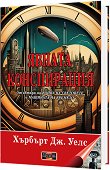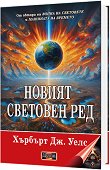Here, in an attractive gift box, are unabridged editions of the five most popular science-fiction novels of
Herbert George Wells.
Five remarkably prescient works by the "father" of modern science fiction include "The First Men in the Moon", a 1901 novel about lunar life; "The Invisible Man", the story of a scientist whose experiments take a terrifying turn; "The Time Machine", a journey into the future; "The Island of Dr. Moreau", the exploits of a mad surgeon; and "The War of the Worlds", a grippingly realistic tale of hostile invaders from Mars.
"The Invisible Man"

First published in 1897, "The Invisible Man" ranks as one of the most famous scientific fantasies ever written. Part of a series of pseudoscientific romances written by H. G. Wells (1866–1946) early in his career, the novel helped establish the British author as one of the first and best writers of science fiction.
Wells' years as a science student undoubtedly inspired a number of his early works, including this strikingly original novel. Set in turn-of-the-century England, the story focuses on Griffin, a scientist who has discovered the means to make himself invisible. His initial, almost comedic, adventures are soon overshadowed by the bizarre streak of terror he unleashes upon the inhabitants of a small village.
Notable for its sheer invention, suspense, and psychological nuance, "The Invisible Man" continues to enthrall science-fiction fans today as it did the reading public nearly 100 years ago.
"The Time Machine"

English novelist, historian and science writer Herbert George Wells (1866–1946) abandoned teaching and launched his literary career with a series of highly successful science-fiction novels. "The Time Machine" was the first of a number of these imaginative literary inventions. First published in 1895, the novel follows the adventures of a hypothetical "Time Traveller" who journeys into the future to find that humanity has evolved into two races: the peaceful Eloi — vegetarians who tire easily — and the carnivorous, predatory Morlocks.
After narrowly escaping from the Morlocks, the "Time Traveller" undertakes another journey even further into the future where he finds the earth growing bitterly cold as the heat and energy of the sun wane. Horrified, he returns to the present, but soon departs again on his final journey.
While the novel is underpinned with both Darwinian and Marxist theory and offers fascinating food for thought about the world of the future, it also succeeds as an exciting blend of adventure and pseudo-scientific romance. Sure to delight lovers of the fantastic and bizarre, The Time Machine is a book that belongs on the shelf of every science-fiction fan.
"The Island of Dr. Moreau"

Considered one of the fathers of science fiction, H. G. Wells (1866–1946) brought enormous inventiveness and an underlying social vision and moral concern to his strange tales and bizarre imaginings. A student of "Darwinian biology", he formed his romantic conceptions of the scientific world at an early age.
This novel, one of his first forays into the science fiction genre, concerns a mad surgeon-turned-vivisectionist who, in his laboratory on a remote island, performs ghoulish experiments in an attempt to transform animals into men, with monstrous results. It is one of Wells' earliest and most sinister personifications of the scientific quest to control and manipulate the natural world, and, ultimately, human nature itself.
"The War of the Worlds"

One of the most famous science-fiction stories ever written, "The War of the Worlds" helped launch the entire genre by exploiting the concept of interplanetary travel.
First published in 1898, the novel terrified readers of the Victorian era with its account of an invasion of hostile creatures from Mars who moved across the English landscape in bizarre metal transports, using deadly heat rays to destroy buildings and annihilate all life in their path. Its power to stir the imagination was made abundantly clear when Orson Welles adapted the story for a radio drama on Halloween night in 1938 and created a national panic.
Despite readers' increasing sophistication about space travel and interplanetary invaders, "The War of the Worlds" remains a riveting reading experience. Its narrative energy, intensity, and striking originality remain undiminished, ready to thrill a new generation of readers with old-fashioned storytelling power.
"The First Men in the Moon"

Of the enormous body of work produced by H. G. Wells – more than a book a year over the course of half a century – the early science fiction novels that first made him famous have proved to be the most enduring and have earned him the sobriquet "the father of modern science fiction".
In the 1901 classic "The first men in the moon", Wells reveals not only a fertile imagination at ease with biological and astronomical phenomena, but also a passionate concern for man and society. His "First men in the moon" provide to be the eccentric Mr. Cavor and his traveling companion, Mr. Bedford, who navigate a gravity-defying sphere through space before executing a rough landing on the moon. As castaways for earth, they practice lunar locomotion, get lost in the wilds of a moon jungle, and confront intelligent life forms living in lunar caverns. Through the adventures of these tow earthlings, the author is able to look at mankind from a distance and, in his words, "burlesque the effects of specialization". The result is a delightful tale filled with adventure, romance, and fantasy that is still capable of stirring the imaginations of readers in the 21
st century.

















